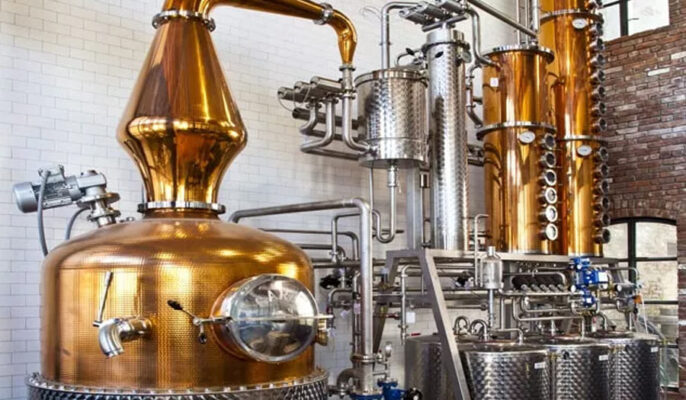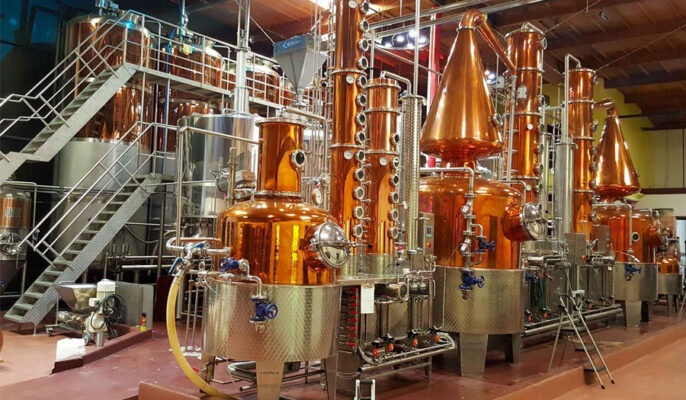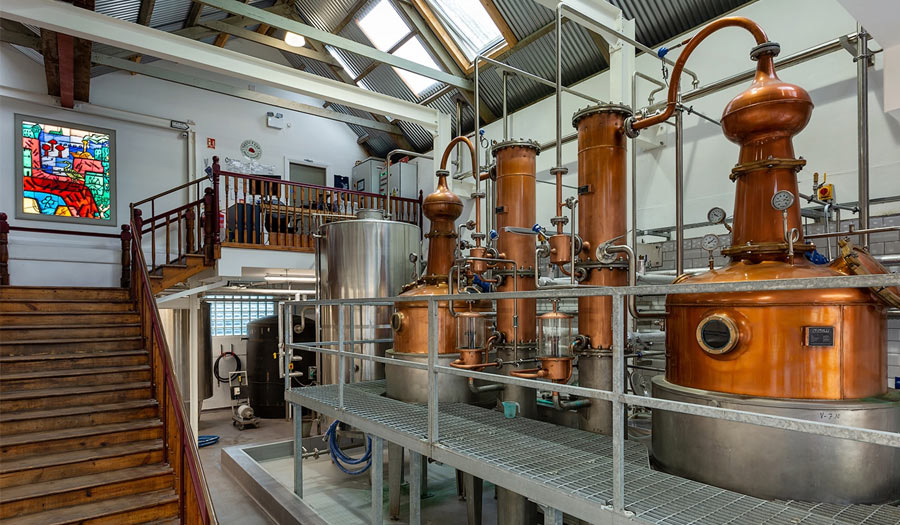In the production process of the brewery, having a set of suitable distillation equipment is the basis for ensuring the efficient and stable operation of the distillation process. This guide will provide you with a detailed list of brewery distillation equipment, including the name, function, characteristics of the equipment, and factors to consider when selecting, to help you build a complete distillation system to meet the needs of brewing production.
Main types and functions of equipamento de destilação
Pote de destilação
Function: As the main container of the distillation process, it holds the material to be distilled. It vaporizes the volatile components in the material by heating, providing a basis for subsequent separation.
Características
- It is usually made of stainless steel or other corrosion-resistant materials to ensure that it will not chemically react with the material during long-term use and affect the product quality.
- It has good thermal conductivity and can transfer heat evenly, so the material is heated evenly, avoiding local overheating and causing material decomposition or coking.
- It is designed with suitable capacity and shape to meet the production needs of different scales. Generally speaking, large breweries may require larger capacity distillation pots, while small factories can choose relatively smaller models.

Condensador
Function: Cool and condense the vaporized steam in the distillation pot into liquid, thereby separating the volatile components from the non-volatile components. The condenser is an indispensable part of the distillation system, and its efficiency directly affects the output and quality of the distilled product.
Características
- Common condensers include shell and tube type, coil type, and plate type. The shell-and-tube condenser has a simple structure and high heat exchange efficiency and is suitable for the distillation process of most breweries. The coil condenser has the advantages of small size and small footprint and is suitable for occasions with limited space. The plate condenser has a high heat transfer coefficient, but it has high requirements for the cleanliness of the material and needs to be cleaned regularly to prevent clogging.
- The material of the condenser is usually stainless steel or copper. Copper has good thermal conductivity, but the price is relatively high, and it may corrode in some specific environments. Stainless steel has good corrosion resistance and is currently a more common choice.
- To improve the cooling effect, the condenser is usually equipped with a cooling medium circulation system, such as a cold water or coolant circulation pump, to ensure that the steam can be quickly cooled and condensed.
Distillation tower
Function: The distillation tower is one of the core equipment in the distillation process. It further improves the purity and separation effect of volatile components through multi-stage distillation. In the distillation tower, the steam and the reflux liquid undergo multiple heat exchanges and mass exchanges to gradually separate the components with different boiling points, thereby obtaining a purer distillation product.
Características
- There are many types of distillation towers, such as plate towers, packed towers, etc. The plate tower has a simple structure and is easy to operate. It is suitable for occasions with large processing volumes and relatively low separation requirements. The packed tower has the advantages of high separation efficiency and small pressure drop, but the selection and maintenance of the packing are relatively complicated.
- The material of the distillation tower is generally the same as that of the distillation kettle, using stainless steel or other corrosion-resistant materials. The tower body is usually designed with multiple layers of plates or packing to increase the contact area and contact time between the steam and the reflux liquid and improve the separation effect.
- To control the temperature and pressure of the distillation process, the distillation tower is usually equipped with instruments such as thermometers and pressure gauges, as well as corresponding regulating devices, such as flow-regulating valves of reboilers and condensers, to make real-time adjustments according to actual production conditions.
Factors to consider when selecting equipamento de destilação
Escala de produção
Determine the production capacity of the required distillation equipment according to the production plan and market demand of the brewery. If the output is large, it is necessary to select distillation kettles, distillation towers, and related supporting equipment with large capacity and strong processing capacity to ensure that the production tasks can be met. For example, a large brewery may need to process several tons or even tens of tons of raw materials every day. At this time, it is necessary to equip large distillation equipment, and multiple sets of equipment may need to run in parallel to improve production efficiency.
Material properties
The volatility and boiling point of the material are some of the key factors in selecting distillation equipment and determining the distillation process. Different materials have different volatility and boiling point ranges. For materials with strong volatility and low boiling point, relatively low temperatures and pressures can be used during the distillation process, and distillation equipment with high heat transfer efficiency and good cooling effect can be selected to reduce energy consumption and material loss.

Product quality requirements
Different brewing products have different requirements for the purity of distilled products. If the purity of the product is required to be high, such as the production of high-purity alcohol, spices, etc., it is necessary to select distillation equipment and processes with high separation efficiency and effective removal of impurities. For example, the use of precision-packed towers or multi-stage distillation towers, combined with efficient condensers and reflux systems, can improve the purity and quality of the product.
Métodos de aquecimento
- Steam heating is a more traditional and commonly used heating method, which has the advantages of uniform heating, easy temperature control, and high thermal efficiency. When there is a steam supply, steam heating can reduce energy costs. However, steam heating requires equipment such as steam generators or boiler rooms, the investment cost is relatively high, and there are certain requirements for the pressure and stability of steam.
- Electric heating has the advantages of cleanliness, convenience, and high control accuracy, and is suitable for some small-scale breweries or occasions with high heating accuracy requirements. However, the cost of electric heating is relatively high, especially in areas with high electricity prices, which may increase production costs.
- Gas heating has the advantages of fast heating speed and relatively low cost, but it needs to be equipped with gas pipelines and corresponding safety equipment. When choosing gas heating, pay attention to the quality and supply stability of the gas, as well as the combustion efficiency and safety of the equipment.
How to maintain and service the distillation equipment?
Equipment cleaning
Regularly clean the outer surface of the distillation kettle, distillation tower, condenser, and other equipment to remove dust, dirt, and other impurities. Use a clean damp cloth or soft brush to wipe to avoid scratching the surface of the equipment. For stains that are difficult to remove, you can use a mild detergent, but make sure that the detergent does not corrode the equipment material.
Inspeção do equipamento
Check the connection parts between the various components of the distillation equipment every day, such as pipe flanges, valve interfaces, pump inlets, outlets, etc. Check whether the sealing gasket is intact and whether there are any signs of leakage. For minor leaks, you can solve it by tightening the bolts or replacing the sealing gasket; if the leak is serious, you should stop the equipment immediately and repair it.

Equipment performance test
The heat transfer coefficient can be calculated by measuring the inlet and outlet temperature, flow rate, and temperature change of the heating or cooling medium, and the material to evaluate whether the heat transfer performance of the equipment has decreased. If the heat transfer coefficient is lower than the design value, it may be caused by scaling inside the equipment, pipe blockage, or other faults, that require further inspection and treatment.
FAQ
What should be paid attention to when starting the distillation equipment?
Before starting, check whether the connection parts of the equipment are well sealed and whether the instrument displays normally, ensure that the cooling system, heating system, etc. are in normal working condition, and then start the equipment step by step according to the operating procedures.
How often does the distillation equipment need to be fully maintained?
Generally, comprehensive maintenance is performed once a year, including checking the main structure of the equipment, cleaning internal dirt, verifying safety accessories, checking the electrical system, etc.
How to clean the inside of the distillation equipment?
For the distillation kettle and distillation tower, after the operation is completed and cooled, they can be rinsed with a suitable solvent or clean water. For severe scaling, chemical cleaning agents can be used, but attention should be paid to the selection of cleaning agents to avoid damage to the equipment.




